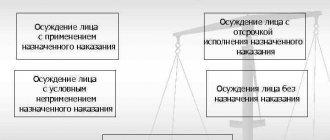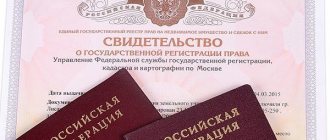Contents of land offenses
A land offence, like any other offence, is characterized by four elements: the object, the subject, the objective side and the subjective side of the offence. Liability for an offense can only arise if all four elements are present; the absence of at least one of them excludes liability.
The object of a land offense is public relations in the field of protection and use of land. The specific subject of the offense is a specific land plot, land regulations, rights of owners, possessors, users, and tenants of land. The objective side of a land offense is the specific acts of a violator who encroaches on the land interests of participants in land relations, resulting in a violation of the legal rights of individuals and legal entities and causing them harm. The objective side of a land offense is characterized by the presence of three elements: illegality of behavior; causing or real threat of causing harm, or violation of other legal rights of participants in land legal relations; a causal connection between the unlawful behavior and the harm caused or the real threat of causing such harm.
Subjects of land offenses are citizens or legal entities who have violated the norms of land legislation (they can be citizens of the Russian Federation and other states, as well as foreign enterprises and organizations). The subjects of the offense are also officials or senior employees of enterprises, organizations, institutions, including government ones. The composition of the subjects of a land offense depends on the type of offense. Thus, the subjects of disciplinary and material liability are officials and employees of enterprises and organizations, criminal – officials and citizens, administrative and civil liability – citizens, officials and legal entities. The subjective side of a land offense is the mental attitude of the subject to the act being committed, that is, how the offender relates to the act being committed. The subjective side is characterized by the guilt of the offender (except for cases of responsibility of the owner of a source of increased danger). The law provides for two forms of guilt: intent and negligence. A land offense is intentional when the offender foresees the onset of harmful consequences of his behavior and desires (direct intent) or consciously allows (indirect intent) them. Carelessness (negligence) is of two types: arrogance (frivolity) and negligence. Arrogance occurs when a person who violated the requirements of the law foresaw the socially harmful consequences of his activities, but frivolously expected to avoid them. Negligence is manifested in the fact that a person did not foresee the occurrence of harmful consequences, although he should have and could have foreseen them.
What are the functions of supervisory authorities in relation to individual entrepreneurs and legal entities
The functions of supervisory structures are:
- warning;
- informational;
- punitive.
Preventive actions are aimed at preventing crime, information activities are aimed at collecting and systematizing information about objects controlled by this body. Punitive measures regulate the identification of those responsible for offenses against the land fund, the determination of the form of punishment for them and the monitoring of the implementation of punishment.
Supervision takes several forms:
- in the form of scheduled and unscheduled inspections;
- continuous monitoring of compliance with legal acts;
- eliminating detected violations.
Monitoring is carried out through a survey of land fund objects and analysis of current legislative documents.
The functions of land control extend to the activities of entrepreneurs in:
- Reclamation of land objects.
- Land improvement.
- Implementation of measures to protect soils from all types of erosion.
- Use of Forest Fund lands to prevent illegal deforestation, change the purpose of land for arable land or for the construction of commercial buildings.
- Compliance with operating standards for areas in the water protection zone.
- Maintaining the level of fertility of agricultural lands.
- Methods of influencing fertile soil layers to prevent unauthorized removal of fertile layers, land depletion and contamination with chemicals.
Signs and types of land offenses
In the current legislation of the Russian Federation there is no precise definition of the concept of “land offences”. However, as a general rule, a land offense should be understood as an unlawful act (action or inaction) directed against the land system established by the Constitution of the Russian Federation and other legislation, the procedure for managing and using land, its protection, as well as against the land rights and interests of legal entities and citizens.
The following types of land offenses are distinguished:
In the field of property protection: unauthorized occupation of a land plot; destruction of boundary signs; use of subsoil without a permit (license), or in violation of the conditions stipulated by the permit (license); damage to land (pollution, removal of fertile soil layer, destruction of fertile soil layer); unauthorized development of areas where mineral deposits occur; unauthorized occupation of a water body or use of it without permission and occupation of a forest fund area or a forest area not included in the forest fund; unauthorized assignment of the right to use land, subsoil, a forest fund plot, a forest plot not included in the forest fund; use of land not in accordance with its intended purpose, belonging to a particular category and permitted types of use; violation of requirements for the rational use of provided land plots.
In the field of environmental protection and natural resource management: non-compliance with environmental requirements during planning, feasibility studies of projects, design, placement, construction, reconstruction, commissioning, operation of enterprises, structures or other facilities; violation of legislation on environmental assessment; unlawful refusal to issue, concealment, distortion of information about the state of the natural environment and land plots that directly affect the land rights and interests of a citizen; violation of rules for the protection of water bodies, water use, operation of water management or water protection structures and devices; violation of rules for the protection of atmospheric air, release into operation of motor vehicles exceeding the standards for the content of pollutants in emissions or noise level standards; violation of forest management rules, incidental forest management, illegal logging, damage or digging up of trees and shrubs, violation of forest protection requirements; damage to agricultural and other lands, untimely return of temporarily occupied lands or failure to bring them into a condition suitable for their intended use; violation of approved urban planning documentation during land allocation and illegal actions of officials and legal entities that resulted in unauthorized occupation of land; violation of the established regime of land use with special conditions for their use; irrational use of agricultural land, failure to implement mandatory measures to improve land and protect soils from water and wind erosion and prevent other processes that worsen the condition of soils, use of land for other purposes, as well as in ways that lead to damage to land; evasion of execution or untimely execution of orders issued by officials exercising state control over the use and protection of lands on the elimination of violations of land legislation.
Land offenses can be classified as: - civil offenses, which include: damage to land, unauthorized occupation of territories, destruction of signs and indicators, development near mineral deposits, use other than for its intended purpose, etc.; — criminal offenses, that is, making transactions with distorted credentials or in a form that does not comply with legal norms, understating the size of land payments, violating the rules and regimes of specially protected zones, carrying out work without complying with environmental protection and protection measures, non-compliance with veterinary, sanitary and epidemiological and other requirements;
Land monitoring
Making adequate and effective management decisions on compliance with land legislation depends on the availability of accurate scientifically based data on the qualitative condition of lands and the changes occurring in them. The source of such data is land monitoring. Monitoring is predominantly technical and information-analytical work related to the use of technical means of monitoring the state of land, taking soil samples and conducting soil-geobotanical surveys, analyzes and measurements of the chemical and biological composition of soils, their physical condition. This is simultaneously a measure of preventive, current and subsequent control. Its data is used to make decisions about the possible location of a particular object, determine permitted types of land use, and thereby serve to prevent such land use, which can lead to land deterioration. Constant soil surveys make it possible to monitor the process of land use and thereby fulfill the tasks of current control. Monitoring also records deviations from permitted behavior, thereby identifying offenses related to pollution, contamination and other types of land degradation, and monitoring data serves as evidence in bringing violators to justice.
In addition to the tasks of identifying changes in the state of land, assessment and forecasting, monitoring provides scientifically based information to government agencies and other interested parties, which is then used to maintain the state land cadastre, organize land use and conduct land management. Monitoring information also serves as a source of information for citizens about the state of the environment in terms of the state of the land (Article 67 of the Land Code).
The point of monitoring is to monitor the dynamics of processes occurring in soils in order to identify the causes and sources of negative changes, make scientifically based decisions to improve land legislation, make necessary adjustments to the legal regime of lands and land use procedures.
State monitoring can be federal, regional and local, depending on the purposes of observation and the observed territory.
At the federal level, the implementation of land monitoring is entrusted to the State Land Cadastre, Roshydromet and the Ministry of People's Republic of Russia with the participation of interested ministries and departments.
Land monitoring is an integral part of monitoring the state of the natural environment and is part of the Unified State System of Environmental Monitoring (USESM). In addition to land monitoring, the Unified State Environmental Monitoring System includes monitoring of the condition of other natural objects, carried out by various federal ministries and departments. The general management of the USSEM is carried out by the Ministry of Natural Resources of Russia.
Monitoring is carried out throughout the Russian Federation in relation to any land plots, regardless of the form of ownership, intended purpose and nature of use. This means that employees of the state monitoring service have the right to carry out the necessary measurements and surveys where and when it is provided, and owners and land users do not have the right to interfere with these actions.
The content of monitoring includes making observations in several areas. During the monitoring process, processes associated with changes in soil fertility (desertification, erosion development, loss of humus, waterlogging, salinization), overgrowing of agricultural lands with weeds and shrubs, land contamination with pesticides, heavy metals and other substances are studied. Monitoring is also carried out over the processes of formation of ravines, landslides and other natural phenomena, the condition of lands occupied by economic facilities, including burial sites of toxic industrial waste and radioactive materials.
The results obtained are accumulated in archives and databases of an automated information system, annually summarized and used to prepare the annual State (national) report on the state and use of land in the Russian Federation.
Types and features of liability for land offenses
Types of liability for offenses in the field of protection and use of land are enshrined in Chapter. XIII Land Code of the Russian Federation. They differ in material terms into: civil, administrative, criminal and disciplinary liability and are applied on the basis of a specific legal act. Compensation for damage caused by land violations is specifically stipulated.
Administrative responsibility. The subjects of this type of liability can be citizens, officials, and legal entities. Responsibility is expressed in specifically defined elements of administrative offenses. The list of land offenses for which administrative liability is provided is given in the regulatory legal acts of administrative and land law. As a general rule, the perpetrators are brought to this type of liability regardless of whether they committed the offense during working or non-working hours. Administrative penalties are applied only by those officials and government bodies that are specified in the law (within the limits of their competence). Time limits for imposing fines: two months from the date of discovery of the offense (in some cases - no later than two months from the date of the offense). Administrative liability is applied in accordance with the procedural procedure defined by law. This type of liability for violation of land legislation occurs: for economic offenses (Article 7.1 of the Code of Administrative Offenses - Code of Administrative Offenses of the Russian Federation); for environmental offenses (Article 8.6 of the Code of Administrative Offenses of the Russian Federation); for violations arising as a result of land reclamation and veterinary medicine (Article 10.9 of the Code of Administrative Offenses of the Russian Federation). Disciplinary liability can only be applied to an employee whose job responsibilities include compliance with land legal regulations. Disciplinary sanctions are imposed for offenses detected during working hours and can be applied in conjunction with property and disciplinary liability.
Civil liability for violation of land legislation is a legal norm that includes property content, which means that the measures applied to the offender are exclusively of a property (material) nature. Accordingly, the application of liability of a property nature presupposes the presence of damage caused (loss of valuables, lost profits, forced costs to eliminate the negative consequences that arose as a result of the harm caused). Civil liability presupposes the financial liability of the offender only to the person whose rights were violated, including property sanctions imposed on the injured party. Responsibility arises for violations of land legislation associated with causing harm to lands, rights and interests of owners. Damage is compensated regardless of whether the perpetrators are brought to other types of liability. The concept of harm can be defined as the derogation of a property benefit.
Disciplinary liability for violation of land legislation arises on the basis of Article 75 of the Land Code of the Russian Federation. The subject of disciplinary liability can only be an employee (worker or employee) whose labor functions include compliance with land legal norms. In this case, the norms of labor discipline are at the same time the norms of labor legislation. It may represent the application of disciplinary sanctions: a) to an employee who has not fulfilled or improperly fulfilled his official duties (Article 192 of the Labor Code - Labor Code of the Russian Federation); b) to an official (in case of non-compliance with labor and other standards, resulting in damage to the land and its subsoil). Property liability arises as a result of the commission of actions that do not fall under the category of transactions with land.
Disciplinary sanctions are applied only for those violations that occurred during working hours. When applying disciplinary liability for land violations, the law does not require a strict procedural procedure; it is enough for the manager to demand an explanation from the violator. The order for collection is issued by the administration of the enterprise where the person works. Disciplinary liability can be applied simultaneously with administrative and material liability. Disciplinary sanctions are applied no later than one month from the date of discovery of the offense and six months from the date of its commission. In cases where a disciplinary offense involves causing material damage, financial liability may also be applied to the employee. Labor legislation provides for the following types of disciplinary sanctions: reprimand, reprimand, severe reprimand, transfer to a lower-paid job, dismissal.
Criminal liability for violation of land legislation occurs for environmental offenses that constitute an encroachment on land as an element that is part of the ecosystem (Articles 254, 246 of the Criminal Code of the Russian Federation); economic offenses that constitute an encroachment on land as an object for economic purposes (Article 167 of the Criminal Code of the Russian Federation); industrial offenses that constitute an encroachment on objects growing from the ground (Articles 231, 260 of the Criminal Code of the Russian Federation).
The Criminal Code of the Russian Federation also provides for sanctions for: violation of the rules established for the fight against plant diseases and pests (Article 249); violation of rules for the protection and use of subsoil (Article 255); illegal cutting of trees (Article 260); destruction or damage of forests (Article 261); violation of the regime of specially protected natural areas and natural objects.
The procedure for implementing criminal liability for violation of land legislation is regulated in the most detail and is determined by criminal, criminal procedural and criminal executive legislation. The basis of criminal liability is the commission of an act containing all the elements of a crime provided for by the Criminal Code of the Russian Federation. Persons who have committed crimes are equal before the law and are subject to criminal liability regardless of gender, race, nationality, property and official status, as well as other circumstances. Criminal liability arises only for those socially dangerous actions (inactions) of a person and the socially dangerous consequences that occur for which his guilt is established. Objective imputation (innocent harm) is not allowed. A number of principles of criminal liability are enshrined in international covenants and constitutional legislation (the principle of legality, justice, humanism). A legal entity cannot be the subject of criminal liability. If a group of people is brought to criminal responsibility, they are recognized as accomplices to the crime, and responsibility for each of them is assigned taking into account the degree and nature of participation in the crime. Bringing a certain person to criminal responsibility as an accused is preceded by: the initiation of a criminal case on the fact of the crime; collection and examination of relevant evidence. The decisive stage of criminal liability is the consideration of the case in court. Relations of criminal liability end with the serving of the sentence assigned to the convicted person, or with release from punishment.
According to the previously existing Criminal Code (Criminal Code of the Russian Federation), the main socially dangerous act was recognized as unauthorized seizure of land (Article 199 of the Criminal Code of the Russian Federation). Nowadays this action is classified as an administrative offense. The new Criminal Code of the Russian Federation has a separate chapter (Chapter 26 “Environmental crimes”, which includes 17 articles. The main one is Article 254 (“Damage of land”), which provides for this act: a fine from 200 to 500 times the minimum wage labor; punishment in the amount of wages or other income of the convicted person for a period of two to five months, or deprivation of the right to hold certain positions or engage in certain activities for up to three years; correctional labor for up to two years. The same acts committed in the zone environmental disaster or in an environmental emergency zone - restriction of freedom for a term of up to three years or imprisonment for the same term. Acts provided for in the first or second case, resulting in the death of a person through negligence, are punishable by imprisonment for a term of at least two years. up to five years.
Land legal liability for violations of land legislation is the forced confiscation of land plots from citizens in connection with the commission of unlawful actions. The procedure and content of this type of responsibility are established by Art. 44-48, 50, 51, 54 Land Code of the Russian Federation, as well as Art. 235 of the Civil Code (Civil Code of the Russian Federation). The legislation distinguishes the basis and procedure for the forced seizure of land from land owners and land users, since they differ significantly both in content and procedure. The only thing in common is that forced seizure of land is possible only by court decision. Confiscation of land plots from owners for land offenses is regulated by the provisions of Art. 235 of the Civil Code of the Russian Federation. The conditions and procedure for the forced seizure of a land plot from persons who are not its owners in connection with their violation of land legislation are established by Art. 54 Land Code of the Russian Federation.
If an offense is detected that is sufficient to initiate a case for seizure of a land plot, the body (or person) exercising state land control imposes an administrative penalty on the offender in the form of a fine in the prescribed manner. Simultaneously with the imposition of the penalty, a warning is issued to the offender about the land violations committed, indicating the period during which the land violation must be eliminated. The offender must be warned about the possible forced seizure of the land plot in the event of failure to eliminate the land offense.
The body competent to provide and confiscate land must be notified of the warning to the offender and the content of the offense. A person guilty of an offense must receive the necessary explanations regarding his rights in the event of initiation of a procedure for termination of rights to a land plot. If the offense is not eliminated within the specified period, the body that issued the warning sends materials on the termination of the right to a land plot to the body competent to provide and seize land plots, which makes a decision on sending the materials to the court. A court decision on termination of the right to a land plot can be appealed to higher courts within ten days, after which the executive body of state power or local government body sends to the body of state registration of real estate and transactions with it an application for state registration of termination of the right to land plot.
Confiscation of a land plot in connection with a violation of land legislation is carried out without compensation to the offender for the cost and losses associated with the confiscation. At the same time, termination of the right to a land plot does not exempt persons guilty of violating land legislation from compensation in the prescribed manner for the cost of damage caused by the offender.
Author of the article
Order of conduct
The procedure for implementing control is carried out through the following measures:
- regular inspections of land plots;
- visiting enterprises that have been allocated land plots;
- if violations of operating rules are detected during the next visit to the land plots of entrepreneurs, officials of regulatory authorities issue instructions to eliminate specific violations and ensure the protection of land, which are mandatory for all categories of entrepreneurs;
- in case of offenses, protocols are drawn up to transmit information about this fact for consideration by the commission, the result of these procedures will be the bringing of the perpetrators to a specific measure of responsibility;
- impose penalties.
Entrepreneurs found to have violated land legislation do not have the right to prevent representatives of supervisory authorities from conducting an inspection. When attempting to exert physical or psychological pressure on supervisory officials, additional forms of punishment may be applied to the perpetrators. Users of land plots are required to ensure their presence on the site during the inspection or delegate one of their employees to represent the interests of the company.
IMPORTANT! If you disagree with the actions or conclusions of officials of state control bodies, entrepreneurs can submit a written complaint to a higher authority or go to court
State land supervision in the Russian Federation
16.03.2020 10:37
Kropotkin department
In accordance with domestic legislation, land and its resources are the main property of the people. It also has a special social value as real estate. To control the fair distribution and intended use of land, state land supervision is carried out.
The concept of supervision. State land supervision refers to the activities of state-authorized bodies aimed at preventing, identifying and suppressing violations of the requirements of the land legislation of the Russian Federation. It does not matter who commits such offenses: state or municipal bodies, legal entities or individuals. Land control is an important management function. It applies to legal provisions for violation of which administrative and other penalties are provided. Its main tasks include:
- organizing and conducting inspections;
- taking measures provided for by law to monitor the implementation of land regulations;
- analysis of the current situation;
- forecasting their implementation in the future.
Land supervision and control over land use are also aimed at taking measures to suppress and eliminate the negative consequences that arose as a result of the offense.
Objects of inspections
The organization of control over the protection and use of land in the Russian Federation provides for verification of:
- land plots,
- parts of land plots;
- land as a natural object and resource.
All objects of supervision can be divided into two groups: general and direct
The first includes land as part of the earth's surface, which is considered as a natural object and an important resource. The direct object is understood as a specific land plot or part thereof. It must be individualized, that is, have clearly defined boundaries, dimensions and location. In addition, a separate category of land or part thereof may be the object of control, since territories are divided according to their intended purpose.
This may include, for example, lands:
- agricultural purposes;
- settlements;
- water and forest resources;
- other categories established by Russian legislation.
Features of public supervision
Land legislation contains the concept of public and industrial supervision. The second type of control represents the actions of the owner of the land plot, land user, owner or tenant in the course of their business activities. These persons independently exercise production control in the field of land use and protection.
We propose to dwell on the last type of supervision in more detail.
The essence and functions of public control
Public control is the activity of citizens and non-governmental non-profit associations, the purpose of which is to monitor the work of government bodies and local self-government in the field of land legal relations, affecting the interests of individuals and legal entities.
Such supervision performs the following functions:
- informational. Involves collecting data on real estate that is under the control of departments;
- warning. Prevents crime;
- punitive. Helps to identify offenses and bring perpetrators to justice.
Subjects of public supervision
According to the provisions of the law, public land control is carried out by citizens, public associations and other non-profit organizations.
The main condition for public supervision is the lack of government funding.
Features of the procedure
As practice shows, most often public control begins at the stage of drawing up plans for the distribution of a site, its zoning, determining the objects that will be located on it, and choosing the recipient of the plot.
In some cases, public activists can use broader powers, for example, to initiate an independent environmental assessment. To do this, you must submit a corresponding application to the municipality.
Surveillance results
If violations are detected, citizens and public associations contact the municipal body, which, based on the data received, is obliged to conduct an inspection.
If the violation of the provisions of the law is confirmed, the competent authority issues an order and an administrative protocol. The perpetrators are brought to justice.
Fines for violations of land supervision
As a rule, for identified discrepancies with the requirements of current legislation, violators are brought to administrative responsibility in accordance with Art. 8.12 Code of Administrative Offenses of the Russian Federation. It imposes a fine, the amount of which is as follows:
- For individuals – no more than 5 thousand rubles;
- For responsible persons - no more than 50 thousand rubles;
- For organizations – no more than 300 rubles.
In addition, legal entities can forcibly suspend work for identified violations in the field of land use for up to 3 months. If during the inspection it is established that due to non-compliance with land legislation, harm was caused to the life and health of citizens, their property, the perpetrators are brought to criminal liability.
Objects of inspections
The organization of control over the protection and use of land in the Russian Federation provides for verification of:
- land plots,
- parts of land plots;
- land as a natural object and resource.
All objects of supervision can be divided into two groups: general and direct
The first includes land as part of the earth's surface, which is considered as a natural object and an important resource. The direct object is understood as a specific land plot or part thereof. It must be individualized, that is, have clearly defined boundaries, dimensions and location. In addition, a separate category of land or part thereof may be the object of control, since territories are divided according to their intended purpose.
This may include, for example, lands:
- agricultural purposes;
- settlements;
- water and forest resources;
- other categories established by Russian legislation.
Authorized bodies and supervised ones
The control function is assigned to state bodies authorized by the Government, as well as their officials. -Rosreestr; -Federal Service for Supervision of Natural Resources (Rosprirodnadzor); – Federal Service for Veterinary and Phytosanitary Surveillance (Rosselkhoznadzor); Officials who have the right to perform a supervisory function are issued a confirming certificate. All information regarding the performance of their duties can be obtained from the territorial divisions of the listed bodies during a personal visit, by telephone or on the official web resources to which they belong. State land control is carried out in the form of:
- Conducting scheduled and unscheduled inspections.
- Systematic monitoring of compliance with the requirements of land legislation. It is carried out through an administrative survey of objects, analysis of legal acts and decisions made by state authorities and local self-government.
- Taking measures to suppress offenses or eliminate their consequences.








